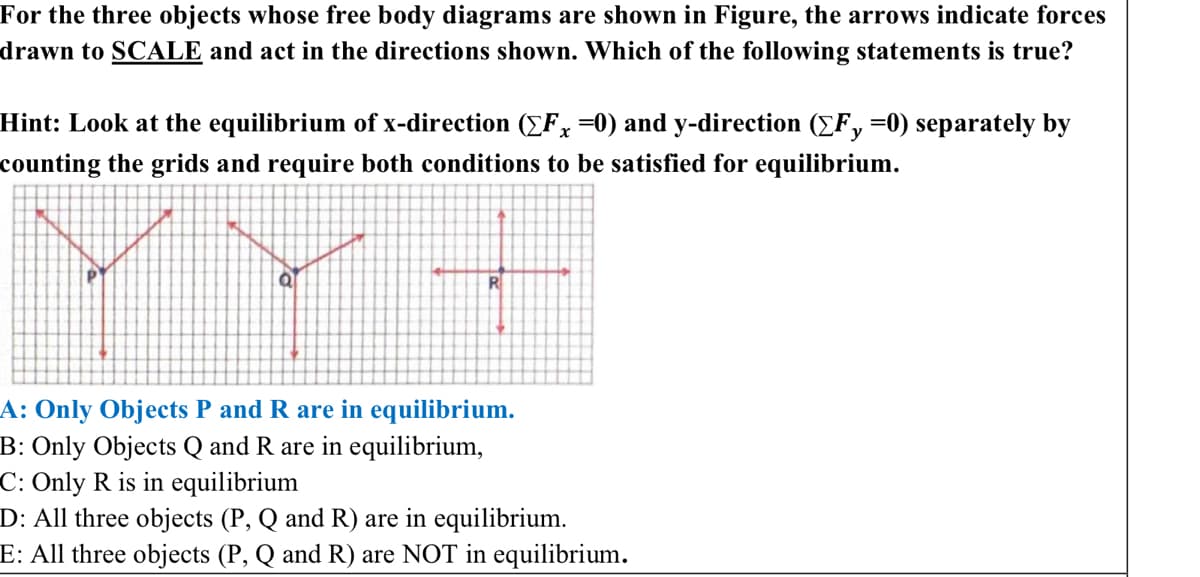For the three objects whose free body diagrams are shown in Figure, the arrows indicate forces drawn to SCALE and act in the directions shown. Which of the following statements is true? Hint: Look at the equilibrium of x-direction (EF, =0) and y-direction (Fy=0) separately by counting the grids and require both conditions to be satisfied for equilibrium. a R A: Only Objects P and R are in equilibrium. B: Only Objects Q and R are in equilibrium, C: Only R is in equilibrium D: All three objects (P, Q and R) are in equilibrium. E: All three objects (P, Q and R) are NOT in equilibrium.
For the three objects whose free body diagrams are shown in Figure, the arrows indicate forces drawn to SCALE and act in the directions shown. Which of the following statements is true? Hint: Look at the equilibrium of x-direction (EF, =0) and y-direction (Fy=0) separately by counting the grids and require both conditions to be satisfied for equilibrium. a R A: Only Objects P and R are in equilibrium. B: Only Objects Q and R are in equilibrium, C: Only R is in equilibrium D: All three objects (P, Q and R) are in equilibrium. E: All three objects (P, Q and R) are NOT in equilibrium.
University Physics Volume 1
18th Edition
ISBN:9781938168277
Author:William Moebs, Samuel J. Ling, Jeff Sanny
Publisher:William Moebs, Samuel J. Ling, Jeff Sanny
Chapter5: Newton's Law Of Motion
Section: Chapter Questions
Problem 32P: Suppose two children push horizontally, but in exactly opposite directions, on a third child in a...
Related questions
Question

Transcribed Image Text:For the three objects whose free body diagrams are shown in Figure, the arrows indicate forces
drawn to SCALE and act in the directions shown. Which of the following statements is true?
Hint: Look at the equilibrium of x-direction ([Fx =0) and y-direction ([F, =0) separately by
counting the grids and require both conditions to be satisfied for equilibrium.
P
a
R
A: Only Objects P and R are in equilibrium.
B: Only Objects Q and R are in equilibrium,
C: Only R is in equilibrium
D: All three objects (P, Q and R) are in equilibrium.
E: All three objects (P, Q and R) are NOT in equilibrium.
Expert Solution
This question has been solved!
Explore an expertly crafted, step-by-step solution for a thorough understanding of key concepts.
This is a popular solution!
Trending now
This is a popular solution!
Step by step
Solved in 2 steps with 2 images

Knowledge Booster
Learn more about
Need a deep-dive on the concept behind this application? Look no further. Learn more about this topic, physics and related others by exploring similar questions and additional content below.Recommended textbooks for you

University Physics Volume 1
Physics
ISBN:
9781938168277
Author:
William Moebs, Samuel J. Ling, Jeff Sanny
Publisher:
OpenStax - Rice University

University Physics Volume 1
Physics
ISBN:
9781938168277
Author:
William Moebs, Samuel J. Ling, Jeff Sanny
Publisher:
OpenStax - Rice University